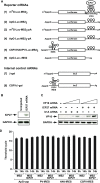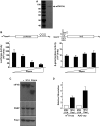Viral and cellular mRNA-specific activators harness PABP and eIF4G to promote translation initiation downstream of cap binding
- PMID: 28559344
- PMCID: PMC5474791
- DOI: 10.1073/pnas.1610417114
Viral and cellular mRNA-specific activators harness PABP and eIF4G to promote translation initiation downstream of cap binding
Abstract
Regulation of mRNA translation is a major control point for gene expression and is critical for life. Of central importance is the complex between cap-bound eukaryotic initiation factor 4E (eIF4E), eIF4G, and poly(A) tail-binding protein (PABP) that circularizes mRNAs, promoting translation and stability. This complex is often targeted to regulate overall translation rates, and also by mRNA-specific translational repressors. However, the mechanisms of mRNA-specific translational activation by RNA-binding proteins remain poorly understood. Here, we address this deficit, focusing on a herpes simplex virus-1 protein, ICP27. We reveal a direct interaction with PABP that is sufficient to promote PABP recruitment and necessary for ICP27-mediated activation. PABP binds several translation factors but is primarily considered to activate translation initiation as part of the PABP-eIF4G-eIF4E complex that stimulates the initial cap-binding step. Importantly, we find that ICP27-PABP forms a complex with, and requires the activity of, eIF4G. Surprisingly, ICP27-PABP-eIF4G complexes act independently of the effects of PABP-eIF4G on cap binding to promote small ribosomal subunit recruitment. Moreover, we find that a cellular mRNA-specific regulator, Deleted in Azoospermia-like (Dazl), also employs the PABP-eIF4G interaction in a similar manner. We propose a mechanism whereby diverse RNA-binding proteins directly recruit PABP, in a non-poly(A) tail-dependent manner, to stimulate the small subunit recruitment step. This strategy may be particularly relevant to biological conditions associated with hypoadenylated mRNAs (e.g., germ cells/neurons) and/or limiting cytoplasmic PABP (e.g., viral infection, cell stress). This mechanism adds significant insight into our knowledge of mRNA-specific translational activation and the function of the PABP-eIF4G complex in translation initiation.
Keywords: DAZL; ICP27; mRNA-binding protein; mRNA-specific translational regulation; poly(A)-binding protein.
Conflict of interest statement
The authors declare no conflict of interest.
Figures











Similar articles
-
Epstein-Barr Virus Protein EB2 Stimulates Translation Initiation of mRNAs through Direct Interactions with both Poly(A)-Binding Protein and Eukaryotic Initiation Factor 4G.J Virol. 2018 Jan 17;92(3):e01917-17. doi: 10.1128/JVI.01917-17. Print 2018 Feb 1. J Virol. 2018. PMID: 29142127 Free PMC article.
-
The flip-flop configuration of the PABP-dimer leads to switching of the translation function.Nucleic Acids Res. 2022 Jan 11;50(1):306-321. doi: 10.1093/nar/gkab1205. Nucleic Acids Res. 2022. PMID: 34904669 Free PMC article.
-
The bent conformation of poly(A)-binding protein induced by RNA-binding is required for its translational activation function.RNA Biol. 2017 Mar 4;14(3):370-377. doi: 10.1080/15476286.2017.1280224. Epub 2017 Jan 17. RNA Biol. 2017. PMID: 28095120 Free PMC article.
-
[Translational control by the poly(A) binding protein: a check for mRNA integrity].Mol Biol (Mosk). 2006 Jul-Aug;40(4):684-93. Mol Biol (Mosk). 2006. PMID: 16913227 Review. Russian.
-
Regulation of poly(A)-binding protein through PABP-interacting proteins.Cold Spring Harb Symp Quant Biol. 2006;71:537-43. doi: 10.1101/sqb.2006.71.061. Cold Spring Harb Symp Quant Biol. 2006. PMID: 17381337 Review.
Cited by
-
Epstein-Barr Virus Protein EB2 Stimulates Translation Initiation of mRNAs through Direct Interactions with both Poly(A)-Binding Protein and Eukaryotic Initiation Factor 4G.J Virol. 2018 Jan 17;92(3):e01917-17. doi: 10.1128/JVI.01917-17. Print 2018 Feb 1. J Virol. 2018. PMID: 29142127 Free PMC article.
-
PABPC1L Induces IDO1 to Promote Tryptophan Metabolism and Immune Suppression in Renal Cell Carcinoma.Cancer Res. 2024 May 15;84(10):1659-1679. doi: 10.1158/0008-5472.CAN-23-2521. Cancer Res. 2024. PMID: 38382068 Free PMC article.
-
Minding the message: tactics controlling RNA decay, modification, and translation in virus-infected cells.Genes Dev. 2022 Feb 1;36(3-4):108-132. doi: 10.1101/gad.349276.121. Genes Dev. 2022. PMID: 35193946 Free PMC article. Review.
-
Dual Leucine Zipper Kinase Regulates Dscam Expression through a Noncanonical Function of the Cytoplasmic Poly(A)-Binding Protein.J Neurosci. 2022 Aug 3;42(31):6007-6019. doi: 10.1523/JNEUROSCI.0543-21.2022. Epub 2022 Jun 28. J Neurosci. 2022. PMID: 35764381 Free PMC article.
-
Preventing translational inhibition from ribosomal protein insufficiency by a herpes simplex virus-encoded ribosome-associated protein.Proc Natl Acad Sci U S A. 2021 Nov 9;118(45):e2025546118. doi: 10.1073/pnas.2025546118. Proc Natl Acad Sci U S A. 2021. PMID: 34725147 Free PMC article.
References
-
- Hentze MW, Gebauer F, Preiss T. cis-Acting regulatory sequences and trans-acting factors in translational control. In: Mathews MB, Sonenberg N, Hershey JWB, editors. Translational Control in Biology and Medicine. Cold Spring Harbor Laboratory Press; Cold Spring Harbor, NY: 2007. pp. 269–295.
-
- Michel YM, Poncet D, Piron M, Kean KM, Borman AM. Cap-Poly(A) synergy in mammalian cell-free extracts. Investigation of the requirements for poly(A)-mediated stimulation of translation initiation. J Biol Chem. 2000;275:32268–32276. - PubMed
Publication types
MeSH terms
Substances
Grants and funding
LinkOut - more resources
Full Text Sources
Other Literature Sources
Miscellaneous

